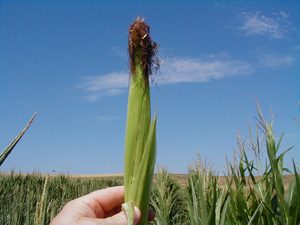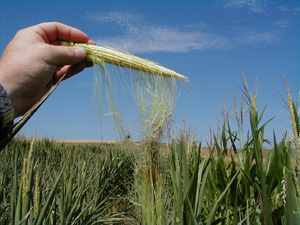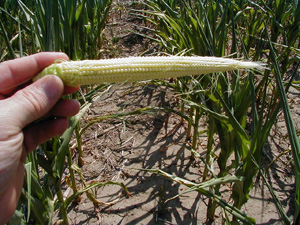G1865
The Use and Pricing of Drought-Stressed Corn
This publication will address identification of drought stress in corn, the effect of drought stress on yield, alternative harvest options and pricing of forage made from drought-stressed corn.
Thomas W. Dorn, Extension Educator
Bruce E. Anderson, Extension Forage Specialist
Richard J. Rasby, Extension Beef Specialist
- The Progression of Drought Stress Symptoms in Corn
- Effect of Moisture Stress on Yield
- Harvest Options for Drought-Stressed Corn
- Harvesting Drought-Stressed Corn as Grain
- Harvesting Drought-Stressed Corn as Forage
- Resources
The Progression of Drought Stress Symptoms in Corn
The first sign a corn plant is under moisture stress is when leaf tissue wilts and rolls during daylight hours when water demand is high but returns to normal turgor during the cooler part of the day when water demand is reduced. As soil water diminishes, eventually plants are no longer able to extract sufficient water to replenish the moisture deficit during cooler periods and the leaves remain wilted day and night (Figure 1). This progresses to death of leaf tissue starting on the tip end and margins of upper leaves and progressing to involve more leaf area over time (Figure 2). The point at which the plant will not recover from moisture stress is known as the permanent wilting point. This results in plant death.
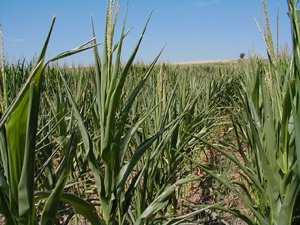 |
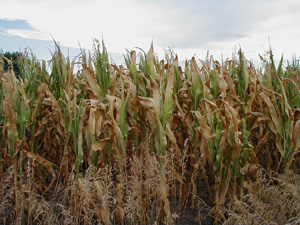 |
| Figure 1. Corn field with leaves rolled showing drought stress. | Figure 2. Corn field with tissue death from drought stress. |
|
Effect of Moisture Stress on Yield
The number of rows of kernels (ear girth) is determined during the time when the sixth to eighth leaf collar is exposed (V6 to V8 stage). The potential number of kernels per row (ear length) is determined during the V10 to V12 stage. If potential ear size is reduced due to moisture stress during these periods, the smaller ear size cannot be increased by relieving moisture stress later in the season. The National Corn Handbook (NCH) estimates four consecutive days of visible wilting during the vegetative growth stage can reduce potential corn yield by five to ten percent.
Drought stress during the early reproductive stages has the greatest impact on yield. Four consecutive days of severe wilting during silking and pollination can reduce yield 40-50 percent. Drought stress affects the timing of ear and ovule development and tassel development differently, sometimes delaying beginning silk until after pollen shed is complete. If kernels aren’t fertilized, they won’t contribute to yield. Since the last ovules to produce silks are at the tip end of the ear, drought stress can result in barren ear tips. If moisture stress occurs after pollination, the least developed kernels may be aborted. This also results in barren ear tips and is known as “tipping back.”
How to Assess Degree of Pollination Success
Within three days after silks are pollinated and fertilization is successful, the silk will detach from the fertilized ovule. To get an early estimate of pollination success, carefully remove the husk leaves from an ear shoot and shake the cob. The degree of successful fertilization can be estimated by observing how many silks readily shake loose (Figures 3-5).
Ten to 14 days after silking, the ovules that successfully pollinated will resemble small white water-filled blisters emerging from the cob. These blisters will rapidly increase in size as the kernels begin the period of dry matter accumulation or seed-fill.
Harvest Options for Drought-Stressed Corn
A number of harvest options are available for drought-stressed corn. Options fall into two general categories — harvesting grain or harvesting forage.
Harvesting Drought-Stressed Corn as Grain
If the corn was successfully pollinated and will produce grain, harvesting grain may be the best alternative. The combine may need several adjustments to accommodate the smaller ear size and lighter test weight grain.
Test weight is one of the factors that determines market grade. Drought stress during grain fill can result in light test weight grain, resulting in lower grain grade and considerable price dock at the elevator. Nonetheless, light test weight corn usually makes good animal feed, often having 90 to 100 percent of the feed value of normal corn. It can be a bargain for the feeder, provided the corn does not contain mold toxins.
Estimating Yield Potential
To estimate potential yield in standing corn, measure a distance equal to 1/1,000 acre along one row and count the number of plants that will produce an ear. Repeat this in several areas and calculate the average ears per acre in the field.
Estimating 1/1,000 Acre Length of row per 1/1,000 acre = 43.56 sq ft/(row spacing in inches/12 inches/foot) = feet of row. For example, with 30-inch rows, 1/1,000 ac = 43.56/(30 /12) = 17.42 ft = 17 feet 5 inches of row. |
Pick two ears at random from each of the areas scouted and count the number of rows of kernels and the number of kernels per row on each ear. Multiply the average number of rows by the average number of kernels per row to get the average kernels per ear in the field. The kernels per ear multiplied by the ears per acre results in the kernels per acre.
There are about 90,000 kernels per bushel in normal corn. Drought-stressed corn will have smaller, lighter kernels — 100,000 to 110,000 kernels per bushel, depending on the severity of the moisture stress during grain fill. Dividing the kernels per acre by the estimated kernels per bushel results in the estimated yield of the drought-stressed corn in bushels per acre.
For example, a dryland field of corn under moisture stress during vegetative stages through pollination and early kernel fill has 16,000 ears per acre that pollinated. Most ears “tipped back” and the field average is 14.3 rows of kernels per ear and 24 kernels per row. The corn is beginning to dent and the producer needs to decide whether to harvest the corn for silage or grain.
The estimated grain yield (assuming enough moisture will be received for photosynthesis to continue and for the transport of starch into the grain) is 50 bushels per acre (16,000 ears per acre x 14.3 rows of kernels per ear x 24 kernels per row / 110,000 kernels per bushel = 49.9 bushels per acre).
The National Corn Handbook estimates “with drought-stressed corn, you can expect to harvest about one ton of silage per acre for each five bushels of corn grain per acre that could have been harvested.” For example, if you expect a grain yield of 50 bushels per acre, you can expect to harvest about 10 tons per acre of 30 percent dry matter (70 percent moisture) silage per acre.
Harvesting Drought-Stressed Corn as Forage
Before directly grazing or mechanically harvesting the corn as forage, check the labels of all chemicals that were applied. Be sure all pesticides (herbicides and insecticides) applied to the crop are cleared for forage and the minimum harvest interval has been met. Also check with the USDA Farm Service Agency to maintain compliance with USDA farm program provisions and crop insurance requirements before harvesting corn as forage.
Potential Nitrate Poisoning
When drought conditions prevent normal plant growth, the corn stalk may contain abnormally high levels of nitrate. Livestock convert nitrate in the forage rumen to other nitrogen compounds. The first step in the conversion process is the conversion of nitrate (NO3) to nitrite (NO2). Some of the nitrite is absorbed across the rumen wall into the bloodstream where it combines with hemoglobin in the blood, producing methemoglobin. Methemoglobin cannot carry oxygen.
Symptoms of nitrate poisoning include: difficult and rapid breathing, muscle tremors, low tolerance to exercise, lack of coordination, diarrhea, frequent urination, collapse and death. When nitrate poisoning is suspected, remove the contaminated feed from the diet, provide a high energy feed such as corn grain, and call a veterinarian immediately.
The veterinarian can administer a methylene blue solution intravenously to counteract the effect of the nitrite on the oxygen-carrying capacity of the blood. Because death can result from an oxygen shortage, handle cattle as little and as quietly as possible to minimize their oxygen needs until they can be helped by the veterinarian.
Under most feeding situations, nitrate-nitrogen (NO3-N) levels over 0.21 percent (also expressed as 2100 parts per million — ppm) are considered potentially toxic. Some laboratories report the concentration of the nitrate ion (NO3-) instead of nitrate-nitrogen (NO3-N). The potentially toxic level for the nitrate ion is 0.93 percent (9,300 ppm). Nitrate testing of feed is especially important if high rates of nitrogen fertilizer or manure were applied, or if the soil has a high organic matter content.
Feedstuffs that test high in nitrates can be used as part of a ration if they are diluted with lower nitrate feeds. For example, you may mix corn silage with alfalfa or prairie hay. Before deciding the percentage of each of the feedstuffs to include in the ration, learn the nitrate levels of all feedstuffs used, then blend the feedstuffs so the total ration does not exceed the potentially toxic threshold level. Balance diets for all nutrients.
Forage Option 1 — Graze Standing Drought-Stressed Corn
Drought-stressed corn can be directly grazed by beef animals with some extra management. Directly grazing standing corn reduces harvest cost by eliminating the need to mechanically harvest the corn forage. This savings may be partially offset by extra labor for strip fencing and extra time to monitor herd health and forage trampling losses.
If allowed unlimited access to the standing corn, experienced cows will seek out and eat mostly the ears. This results in a diet with a high grain content which can lead to acidosis. Slowly acclimate cattle to higher grain intake by feeding them increasing amounts of grain for a week or more before allowing them to begin grazing the standing corn.
To minimize waste from trampling and to limit grain consumption, use an electric fence to limit access to only that portion of the field that will be consumed in no more than two or three days. The fence should then be moved to open a new strip.
Never turn hungry cattle into standing corn to graze. Always have cattle full of low nitrate forage before turning them in to graze standing corn for the first time. It is wise to supplement cattle feed with a high quality hay source or remove the cattle to pasture where they can graze forage low in nitrates for part of the day at first, then slowly reduce the amount of supplemental forage fed until they are receiving only the corn forage.
Nitrates are not evenly distributed in the corn plant. Nitrate levels are fairly low in the leaves and higher in the stalk, with the lower stalk having the most nitrate. Animals will eat the ears and leaves first, then the upper stalk. They will only eat the lower stalk when there is no alternative feed available. When grazing standing corn, don’t force animals to consume the lower stalk since it contains higher levels of nitrates. Provide access to plenty of clean water, salt and mineral at all times to cattle grazing drought-stressed corn.
Forage Option 2 — Harvest and Feed Greenchop
Harvesting corn with a silage chopper and feeding it fresh to cattle instead of first letting it go through the ensiling process is known as feeding greenchop. Feeding greenchop minimizes waste and improves utilization of available forage compared to direct grazing in the field; however, feeding greenchop requires great care. Nitrates accumulate in the lower 8 to 10 inches of the stalk in drought challenged corn. Set the cutter height to avoid harvesting the lower part of the stalk.
If drought-stressed corn is fed as greenchop, it should be fed immediately after it is harvested. Never allow green-chopped forage to heat in the truck or in the feed bunk because nitrate will quickly convert to nitrite. Nitrite can be ten times as toxic as nitrate when fed to animals.
Have plenty of bunk space available (36 inches of bunk space per cow is recommended) so “boss” cows don’t overeat and timid cows can get their share, then chop only the amount that will be eaten in two hours. It is better to feed small amounts of freshly harvested greenchop two or three times daily rather than one large feeding per day to avoid heating that could occur in the feed bunk before the greenchop is consumed.
Forage Option 3 — Harvest and Feed Corn Silage
Feeding silage made from drought-stressed corn is preferred to direct grazing or feeding greenchop because ensiling reduces nitrate levels in the feed. During the ensiling process, one-third to one-half of the nitrate in the forage is usually converted to nitrous-oxide compounds which leave the silage pile as a gas.
The tendency is to cut drought-stressed corn for silage too soon, resulting in silage with excess moisture. Excessive moisture results in poor fermentation and reduced feed value. Always test moisture content of a representative sample before filling the silo. If the moisture content is above 70 percent, either wait to harvest, windrow the corn and let it field wilt before chopping for silage, or mix silage with dry ingredients like cracked corn, dried distillers grains, or ground hay to bring the moisture content down to 65 to 70 percent for proper ensiling. It takes about 35 pounds of corn, dried distillers grains, or hay (assuming 88 to 90 percent dry matter) to reduce the moisture content of one ton of wet silage by one percentage point.
If drought-stressed corn has pollinated, delay harvest as long as some green leaf and stalk tissue remains and the black layer has not formed on kernels. Rainfall and subsequent relief of moisture stress can increase grain dry matter and silage quality.
The feed value of drought-stressed corn silage is usually 90 to 100 percent of the feed value of normal corn silage even though the percentage of grain in the drought-stressed silage is less than in normal silage. This is because the metabolites that would normally be deposited in the grain are still present in the stalks and leaves of the drought-stressed plants. We recommend testing forages, whether from normal or drought-stressed plants, before using them in a ration. Silage should be tested for moisture percentage, percent crude protein, percent TDN, and nitrate content.
Pricing Drought-Stressed Corn Silage
A long-standing rule of thumb was that a ton of normal corn silage at 65 percent moisture that has been ensiled is worth 10 times the price of a bushel of shelled corn. This relationship may not be as valid now as it was, due to the demand for corn to produce ethanol. The following pricing methods might estimate the value of drought-stressed silage more closely when compared to alternative forage-based feed sources.
- Silage Pricing — Method 1. Establish a minimum price as the basis to negotiate a final price. The National Corn Handbook states, “At the minimum, each ton of silage is worth about five times the current price per bushel of shelled corn plus $2.00 per ton to cover the added cost of harvesting and storing corn silage rather than grain.” For example, if shelled corn is selling for $6 per bushel, the minimum price for drought-stressed silage would be $6 per bushel x 5= $30 plus $2 = $32 per ton.
(Harvest costs have been adjusted, based on 2008 Machinery Cost Estimates, published by the University of Minnesota. Assumptions: Forage yield = 10 tons per acre. Ensiling shrink = 10%.)
- Silage Pricing — Method 2. Compare to alfalfa hay. Perhaps the most direct method of pricing drought-stressed corn silage as a feed is to compare it with other forage sources. The National Corn Handbook states “One ton of 30 percent dry matter corn silage will substitute for about one-third of a ton of 85 percent dry matter alfalfa hay and would be priced accordingly.” For example, if alfalfa hay is selling for $100 per ton, a ton of normal corn silage would be priced at $33 per ton and drought-stressed silage would be priced at $33 x 90 percent = $30 per ton.
Forage Option 4 — Bale Dry Corn Stover
If the corn will not make sufficient grain to harvest with a combine and if there is no nearby market for silage, a final marketing alternative is to windrow the corn while it still has some green tissue, let it field dry and then put it up as stover. Although tonnage will be reduced, avoid cutting the lower eight to ten inches of the stalk as this is where the highest concentration of nitrates will accumulate in drought-stressed corn. In addition, leaving a taller stubble will help to elevate the windrow off the ground, allowing air to circulate better through the forage and aid in drying. The advantage of dry forage as compared with silage is there is far less tonnage to haul.
One disadvantage to harvesting drought-stressed corn as dry forage rather than silage is that unlike ensiling, nitrate level does not decline after harvest when the forage is allowed to dry. Use extra caution when feeding dry forage. If the initial nitrate test comes back high, cut the plants higher, eight to twelve inches above the ground, to reduce the nitrate content of the forage. Always test the nitrate content in the dry forage before feeding it to animals.
Pricing Dry Corn Stover
Dry corn stover made from drought-stressed corn can be compared to drought-stressed corn silage as an alternate feed source. If the two products have the same nutrient content on a dry matter basis, the price of dry forage might be based on the price of drought-stressed corn silage, corrected for differences in waste.
A ton of 70 percent moisture (30 percent dry matter) silage contains 2000 x 0.30 = 600 pounds of dry matter. A ton of 20 percent moisture (80 percent dry matter) dry corn stover contains 2000 x 0.80 = 1600 pounds of dry matter. However, unless the corn stover is put through a grinder to reduce particle size, animals will sort, eating the leaves, ears, and small stems but leaving the coarser stems. If we assume there will be 20 percent more waste when feeding dry corn stover as compared to feeding silage, the useful dry matter in a ton of stover would be 1280 pounds. By this reckoning, a ton of dry corn stover would contain 1280/600 = 2.13 times as much useful dry matter per ton than corn silage. If drought-damaged silage is selling for $30/ton, dry drought-stressed corn stover with the same nutrient content might be expected to sell for about $30 x 2.13 = $64 per ton.
The local market value of any forage made from drought-stressed corn will depend on the availability of alternative feed sources, the nitrate content of the stover, and the transportation costs compared to alternative feed sources.
Resources
National Corn Handbook, Published by Purdue University http://www.ces.purdue.edu/extmedia/agronomy.htm
National Corn Handbook — Utilizing Drought Damaged Corn http://www.ces.purdue.edu/extmedia/NCH/NCH-58.html
How a Corn Plant Develops, published by Iowa State University http://www.agronext.iastate.edu/corn/production/management/growth/
2008 Machinery Cost Estimates — published by University of Minnesota http://www.apec.umn.edu/faculty/wlazarus/documents/mf2008.pdf
All photos by Thomas W. Dorn, UNL Extension Educator
This publication has been peer reviewed.
Visit the University of Nebraska–Lincoln Extension Publications Web site for more publications.
Index: Corn Production/Field Crops
Corn
Issued July 2008
